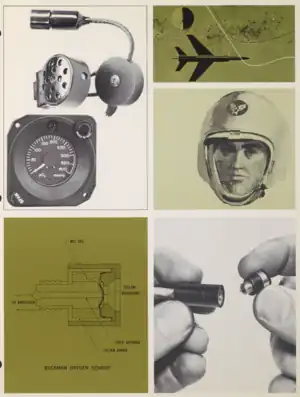Generalized hypoxia
| Generalized hypoxia | |
|---|---|
| Other names | Arterial hypoxia |
 | |
| Oxygen sensor for hypoxia warning system, 1963 | |
| Specialty | Pulmonology |
Generalized hypoxia is a condition in which the tissues of the body are deprived of the necessary levels of oxygen. This is not to be confused with hypoxemia, which refers to low levels of oxygen in the blood, although the two conditions often occur simultaneously, since a decrease in blood oxygen typically corresponds to a decrease in oxygen in the surrounding tissue. However, hypoxia may be present without hypoxemia, and vice versa, as in the case of infarction.
Causes
Restricted oxygen flow to the body's tissue that leads to hypoxia can be caused by a variety of situations or other underlying conditions.
- High altitude (above 3048 metres/10,000 feet)
- Hypoventilation – failure of respiratory pump due to any cause (fatigue, barbiturate poisoning, pneumothorax, etc.)
- Ventilation perfusion mismatch
- Obstructed airway
- Drowning
- Abnormal pulmonary function
- Chronic obstructive pulmonary diseases (COPD)
- Neuromuscular diseases or interstitial lung disease
- Constrained blood flow to a tissue (such as atherosclerosis or vasoconstriction)
- Blockage in blood flow like a sickle cell crisis
- Low or no blood flow caused by bleeding or heart attack
- Malformed vascular system such as an anomalous coronary artery
- Limited oxygen transportation due to anemia
While respiring in the open air at high altitudes, the human body experiences altitude sickness and hypoxemia due to a low partial pressure of oxygen, decreasing the carriage of oxygen by hemoglobin.
- Above 3000 metres (10,000 feet) - enough hypoxic stimulation to cause increased ventilation
- Above 3700 metres (12,000 feet) - first irritability appears
- Above 5500 metres (18,000 feet) - severe symptoms
- Above 6100 metres (20,000 feet) - consciousness lost
While breathing pure oxygen, through oxygen cylinder or other means, the maximum height a human can reach while their body is in atmospheric pressure is 13,700 metres (45,000 feet)
Signs and symptoms
- Cyanosis
- Headache
- Decreased Reaction Time[1]
- Impaired judgment
- Euphoria
- Visual impairment
- Drowsiness
- Lightheaded or dizzy sensation, vertigo
- Tingling in fingers and toes
- Numbness
- Pain
- Stroke
Treatment
Oxygen therapy and hyperbaric medicine can improve saturation of oxygen in the blood which will stop hypoxia if it is caused by hypoxemia, i.e. low levels of oxygen in the blood.
Surgery can redirect blood flow to tissue that was previously starved of blood. In the event of a damaged blood vessel, hemostasis is the process employed for the prevention and cessation of bleeding. In the extreme case that a heart has stopped beating, defibrillation is used to attempt to restart it.
Angioplasties and stents are used to widen narrowed arteries and veins that may have restricted blood flow, while medication can be used to thin the blood or reduce plaque.
A healthy diet and lifestyle will prevent or lower the chance of experiencing a medical condition that causes hypoxia and will make congenital defects that cause it less likely to occur.
See also
References
- Flight Standards Service. Pilot's Handbook of Aeronautical Knowledge: FAA Manual H-8083-25. Washington, DC: Federal Aviation Administration, U.S. Dept. of Transportation, 2001. ISBN 1-56027-540-5.